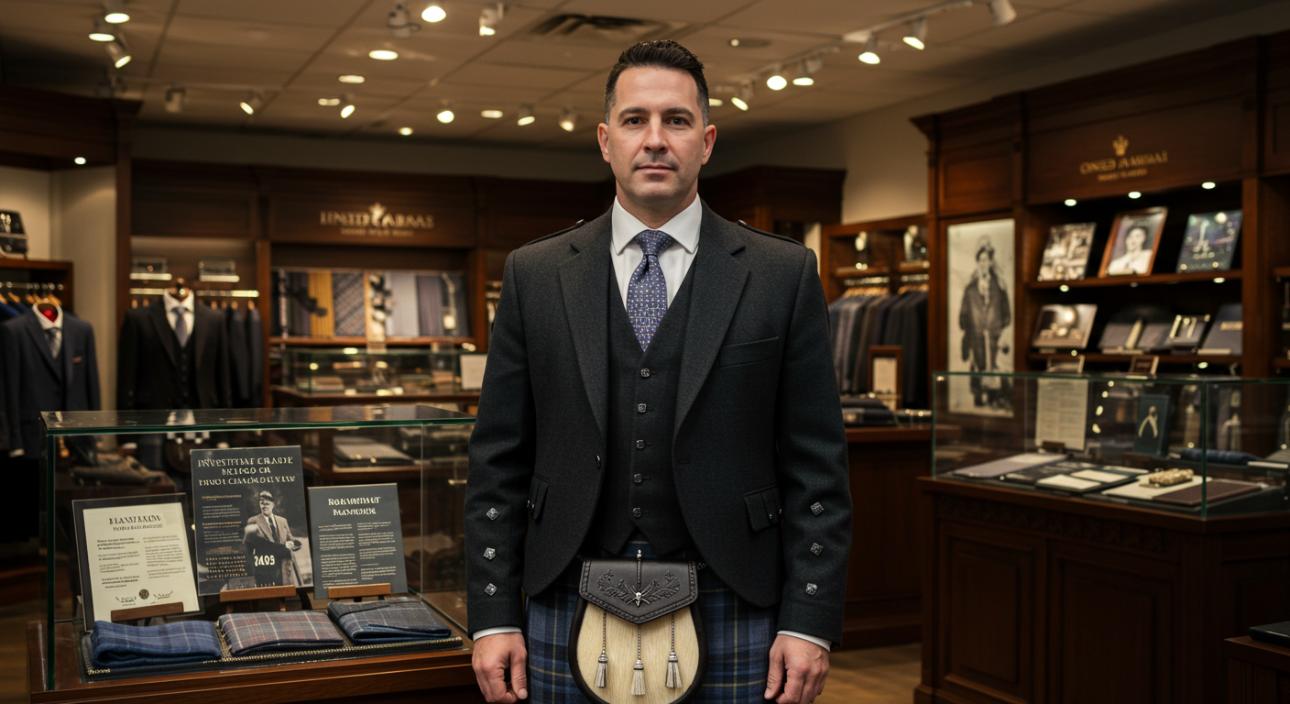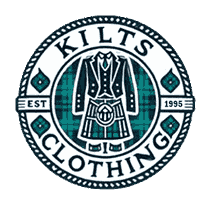The Economics of Formal Kilts: Understanding the Investment in Quality Highland Wear

Formal kilts, an iconic Highland wear, have long been associated with Scottish culture, symbolizing tradition, elegance, and status. Whether worn for weddings, ceremonies, or other special events, kilts are far more than just garments—they reflect heritage and craftsmanship. However, with prices ranging from a few hundred to several thousand dollars, many wonder if a high-quality formal kilt investment is worth it. In this blog, we'll explore why investing in a quality kilt is not just about the cost but about its long-term value, from craftsmanship and durability to cultural significance and sustainability.
1. The Cost Breakdown of a High-Quality Formal Kilt
The cost of a formal kilt can vary widely, depending on several factors, such as fabric, customization, and craftsmanship. A high-quality kilt can cost anywhere from $500 to $1,500 or more. This pricing typically includes the kilt itself and the necessary accessories like a sporran belt, kilt pin, and hose. Some kilts are made from wool, tweed, or cashmere fabrics. They naturally come with higher price tags due to their superior quality and longevity.
The key to understanding the investment in a kilt lies in its components. A well-made kilt is made from durable fabrics, hand-stitched pleats, and reinforced seams that ensure it can stand the test of time. The tartan pattern, whether a family-specific clan design or a custom creation, is often woven from the highest-quality wool, contributing to its appearance and feel.
Custom kilts, which allow for personalized tartan choices, unique fit, and specific tailoring, generally come at a higher price. However, they offer the added benefit of ensuring the kilt fits you perfectly, reducing the need for future alterations. A mass-produced, off-the-shelf kilt may save you money initially. Still, it won't provide the same level of quality or personalization.
2. The Importance of Craftsmanship and Materials
When investing in a formal kilt, the craftsmanship and materials truly define the garment's value. High-quality kilts are meticulously handcrafted by skilled artisans who follow time-honored techniques, ensuring that each piece is beautiful and functional.
The materials used to make a formal kilt are crucial for its durability and comfort. Wool, the traditional fabric for kilts, is known for its breathability, warmth, and resilience. Wool is also a sustainable option since it is biodegradable and renewable. Fine cashmere or a wool blend is often used for those seeking a more luxurious feel. These materials are naturally moisture-wicking, making them ideal for warm and cold weather conditions.
In addition to fabric quality, the intricate weaving of the tartan pattern contributes to the kilt's cost. Handwoven tartans are more expensive than machine-made alternatives, especially those made from natural fibers. This craftsmanship ensures the pattern is rich in color, texture, and authenticity, making the kilt a piece of clothing and a work of art.
3. Custom Kilts vs. Ready-Made Kilts: The Price Difference
When deciding between a custom formal kilt for sale and a ready-made option, weighing the price against the benefits is essential. Ready-made kilts are typically mass-produced and sold at lower prices, ranging from $200 to $600. While they offer a quick and affordable solution, they often come in standard sizes and limited tartan choices. The fit may not be perfect, and the quality of the fabric may not match that of a bespoke kilt.
On the other hand, custom kilts—designed to fit your measurements and specific preferences—are significantly more expensive. These kilts are tailored to ensure an impeccable fit, which is essential for comfort and appearance. The customization options for fabric, tartan, pleating style, and accessories allow you to create a one-of-a-kind garment that perfectly reflects your personality and heritage.
Investing in a custom kilt offers far more value in the long run. A well-tailored kilt that fits appropriately will look better and be more comfortable, allowing you to wear it for years without significant alterations. Additionally, the quality of craftsmanship and materials in a bespoke kilt ensures that it can be worn multiple times, making it a long-term investment.
4. Durability and Longevity: The Return on Investment
One of the primary reasons why investing in a high-quality formal kilt makes sense is its durability. A formal kilt made from premium materials, like wool, and crafted with care can last decades if properly maintained. Unlike cheaper kilts that may lose shape, color, or fabric integrity over time, a high-quality kilt retains its form and beauty for years, making it a worthwhile investment.
The durability of a kilt is paramount when considering its potential to become an heirloom piece. Many families pass down their kilts through generations, with the garment's rich history and craftsmanship making it even more valuable. The lasting nature of high-quality kilts means they can be worn at multiple events, passed on to children or grandchildren, and appreciated for their quality and heritage.
While you may initially pay more for a well-crafted kilt, its long lifespan and ability to stay in excellent condition will ultimately give you a return on your investment. Lower-priced kilts may require frequent replacements or repairs, which add up over time.
5. The Role of Kilts in Special Occasions and Ceremonial Wear
Formal kilts are not everyday wear; they are typically worn for special occasions—weddings, graduations, military events, and other ceremonial functions. The price for a kilt formal reflects the materials, craftsmanship, and value it adds to these critical moments.
A custom kilt enhances the experience of these special occasions. Whether wearing it for your wedding or a milestone family celebration, a well-fitted, high-quality kilt contributes to your sense of pride and connection to your heritage. The significance of kilts in such events makes them more than just an outfit; they become integral to creating memories and traditions that can last for generations.
In addition to weddings, kilts are often worn at events like Burns Night Suppers, Highland Games, and other ceremonial functions, symbolizing Scottish pride. When you invest in a formal kilt, you're not just purchasing clothing but a garment that will be part of many important moments in your life.
6. The Economic Benefits of Buying a Bespoke Kilt
Bespoke kilts, although more expensive than ready-made options, offer significant value in the long run. The perfect fit, personalized tartan choice, and attention to detail make them a wise investment for those who value style, comfort, and longevity. A bespoke kilt designed for your specific measurements will enhance your appearance and provide comfort during long events or ceremonies.
In addition, a bespoke kilt is tailored to your preferences, whether that means a particular tartan, fabric, pleating style, or custom embroidery. This level of personalization ensures that your kilt is unique to you and can be worn with pride for years.
While the upfront cost may be higher, the long-term benefits—including the superior fit, craftsmanship, and customization—make bespoke kilts a more economical choice in the long run, especially for those who plan to wear them frequently.
7. The Growing Trend of Sustainable Fashion and Highland Wear
The fashion industry is becoming increasingly aware of its environmental impact, and many consumers seek sustainable alternatives. High-quality kilts align well with this trend, as they are often made from natural materials like wool and tweed, which are biodegradable and renewable. By investing in a formal kilt, you're choosing an eco-friendly option that lasts longer, reducing the need for constant replacements.
Additionally, high-quality kilts are timeless in design, ensuring they never go out of fashion. Rather than follow fleeting trends, kilts remain a classic choice for formal wear, offering an eco-conscious option for those who prefer sustainability over fast fashion.
8. The Social and Cultural Value of a Formal Kilt
In addition to their functional value, kilts carry significant social and cultural importance. They are a powerful symbol of Scottish heritage, representing pride, tradition, and status. Owning a formal kilt, mainly made from high-quality materials, connects the wearer to a rich cultural history spanning centuries.
Wearing a well-crafted kilt at formal events can also enhance your social standing. It marks you as someone who values tradition and understands the importance of quality craftsmanship. A kilt can even become a conversation piece, sparking discussions about your family's history or your connection to Scottish culture.
9. How to Care for Your Formal Kilt: Protecting Your Investment
A high-quality kilt is an investment; proper care ensures it stays in excellent condition for many years. Following care guidelines is essential to maintain your kilt's appearance and durability. For wool kilts, dry cleaning is recommended to preserve the fabric's texture and color. You should also store your kilt in a cool, dry place, away from direct sunlight, to prevent damage or fading.
Proper care extends to accessories like the sporran, belt, and kilt pins. Keeping these items clean and well-maintained will help retain their value and appearance.
10. Conclusion: Making the Case for Investing in a Quality Formal Kilt
When it comes to formal wear, a high-quality kilt is more than just a piece of clothing; it's an investment in style and heritage. From the superior materials and craftsmanship to the durability and cultural significance, a well-made kilt offers long-term value that is unmatched by cheaper alternatives.
While the initial cost of a formal kilt may seem high, the investment pays off in timeless design, durability, and the ability to pass down the garment through generations. Whether worn for weddings, ceremonies, or other special occasions, a high-quality kilt is an essential piece of Scottish heritage that will continue to provide value for years.


